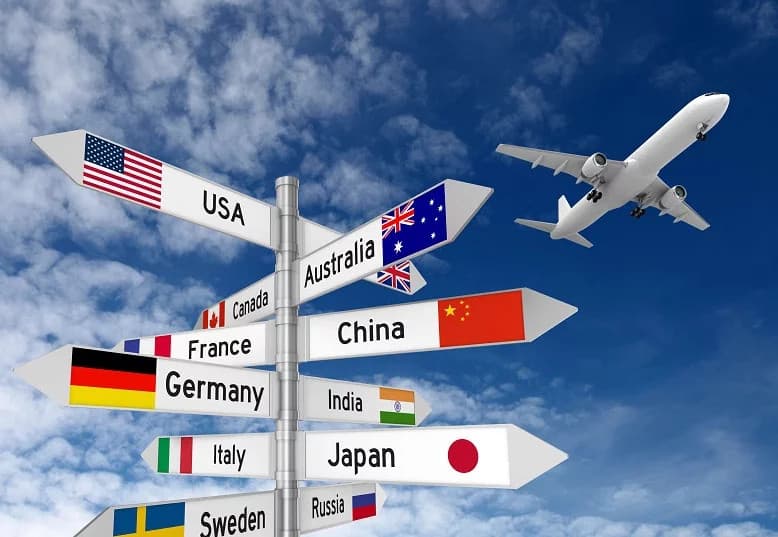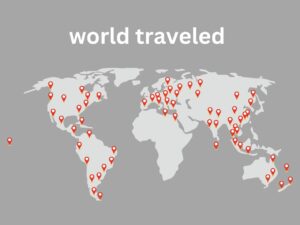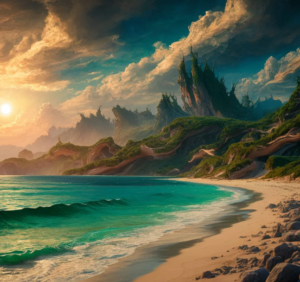Travel. Everything you need to know to travel more and better.
I believed that travel would be part of everyone’s life, but I met some people who didn’t plan on traveling. These people like to stay in the comfort of their home and their own comfort zone. Fortunately, this is not the case for the majority, but only a few actually succeed.
I always wanted to know the world. Initially, due to personal situations, I didn’t have the opportunity to travel, but despite that, my father took us walking around the neighborhood and that always enchanted me, with the discovery of a new place.
As time passed, I was able to walk further and further away. With my curiosity, I decided, from an early age, to explore the unknown.
So, today, after traveling around the world a lot, I decided to create The Wander Traveler Project.
With the aim of traveling more, to see the world as it is, living enriching experiences, interacting with people, cultures and places, always in search of personal and societal development, through understanding and accepting differences.
The Wander Traveler project:
The main objective of The Wander Traveler blog is to empower everyone, with knowledge and tools that allow everyone to travel more and more and have a better travel experience. Thus making people happier and more understanding, for having known the diversity and truths of this world.
When I started traveling, I didn’t have an idea of what this could be like, but I discovered it over time. On the one hand, discovery is very rewarding, on the other hand, it takes a long time and makes traveling difficult. Even so, we can learn from our mistakes, but we have no guarantee of discovering the best way to travel.
In addition, of course, you can miss many opportunities due to inexperience and lack of access to correct information, as we have a lot available on the internet, but we have to be careful with “tricks” and fake news.
So here, in The Wander Traveler project, I want to show you everything I’ve learned in the last 30 years of traveling, the new tools and changes in tourism, to make your life easier.
I do not intend to give formulas or recipes, on how to do this or that, but rather to empower everyone to find the best way to travel, using everything that is available and prepare for what is to come.
Do you know all the steps to have an exceptional trip?
To do this we need to get everyone on the same page, that is, get everyone at the same level of general knowledge.
Currently, everything is very dynamic and new possibilities arise every day, so I will keep you updated and if you know of anything that is missing or needs further explanation, please get in touch or leave the comments below.
I – Types of trip.
We can classify trips as follows.
A – Purpose
1 – At Work:
I believe it is one of the best known and most used, where you go somewhere to perform some work.
- It could be the installation of equipment.
- A meeting with someone from your company.
- A sales trip.
- To visit a customer or prospect new ones.
- A training or workshop.
We can classify work travel into two categories:
- Professional: These are those that are determined by the company, generally you don’t have much control over them.
- Voluntary: These are those that, even when related to work, depend entirely on your decision. How to be a United Nations volunteer, or do volunteer work in Africa.
2 – Vacations:
This is certainly the second best known and also the one that is most difficult to plan and execute.
We always keep putting it off because:
- You can’t go on vacation.
- Money is short.
- Difficulty balancing children’s holidays, work and studies.
- Choose the best destinations.
- How much does it cost to travel?
3 – Studies:
These are those trips you take to take a course or workshop, with the aim of improving your knowledge, they are normally paid for by you and are part of your learning.
- Language course in another country.
- Workshop on medicine, law, etc.
- Participate in summer courses at universities
- Etc.
B – Duration of the Trip.
All of the above types can also be divided into short or long.
What is short or long can vary a little, but for the sake of discussion we will allow up to 30 days to be short, beyond that they will be long term.
1 – Short trip within 30 days:
These are the ones that require a little planning, but at a simple to intermediate level, as they do not drastically change the traveler’s life.
Generally, all commitments are only “suspended for this short period, or are carried out remotely, such as payments, family care.
As you will be traveling for a few days, everything may be “suspended” and return to normal upon your return.
2 – Long trips, more than 30 days:
This already requires a lot of planning. The longer it is, the more the characteristics of life need to be considered.
It is also important to make a plan for your return, as many of your commitments will have to be canceled and your return may be more or less traumatic.
How to plan your trip around the world of your dreams.
Get the knowledge and tools that will make you an expert in traveling around the world, with
- Total freedom of choice.
- Lower cost because you do not have to pay anyone to do it for you.
- You can change your plans at any time and for any reason.
- You can cancel, change and simply do not pay fines or penalties.
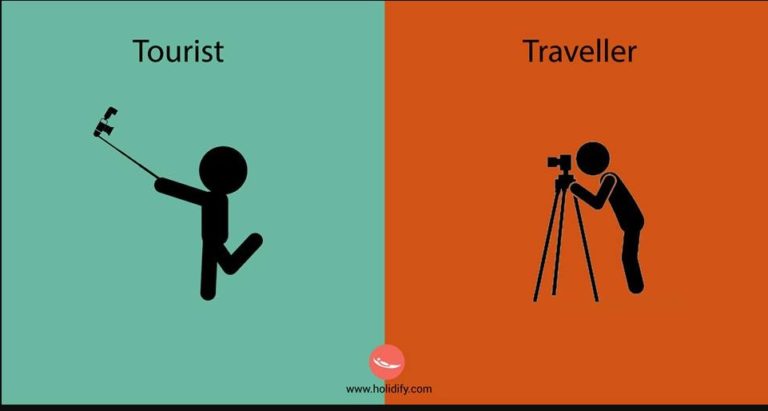
II – Your type of traveler.
One of the factors that most influences travel satisfaction and experience is knowing what type of traveler you are, making it easier to find your best destination.
The better you know yourself and adapt your trip to your style, the better your traveling experience will be.
Have you ever heard that phrase? Be careful what you ask for.
Here this fits perfectly. If you plan a vacation one way and your profile is another, you will most likely hate the trip.
So let’s explore the most common types of travelers a little.
A – The standard Tourist:
It is the tourist who follows the standards. It has the following features.
- He looks for the ready-made travel packages.
- The tours are well formatted.
- Eating in restaurants, where everyone is.
- Go to the standard times and attractions of each place.
- Traveling as standard as possible.
B – The Exploring Tourist:
This is what, although the majority follows, they try to find an alternative. Its characteristics are as follows:
- He even goes to the standard places, but tries to discover something more in each place.
- Look for some alternative tours.
- Likes to try new restaurants, shows, etc.
- It follows the standard, but tries to find something more.
C – The independent tourist:
This is the restless type and doesn’t like to follow the norm, wanting to avoid mass tourism in favor of an individualized and independent approach.
They tend to want to explore their chosen destinations at their own pace, with an emphasis on enjoying local food, architecture, history and culture.
Its characteristics are:
- Rarely goes with the flow.
Prefers to explore places, without a pattern to follow. - Normally, you do not use closed travel packages.
- Avoid being in the places and times that other common tourists are as much as possible.
- Prefer to travel cheap.
- Rarely goes with the flow.
D – Luxury Tourist and/or themed trip.
They are tourists who like to feel unique. Its characteristics are:
- Exclusive services/services.
- They don’t like to feel like they’re common people.
- They may even be in the same places, but with personalized treatment.
- Furthermore, they like a certain isolation such as SPA, all-inclusive, cabins, etc.
E – Business tourist.
These are those who are traveling for work. Its characteristics are.
- There is very little time in each place.
- They generally visit few places and only the main ones.
- They prefer restaurants, stores and shows where “professionals” frequent.
- You always have to maintain an attitude consistent with the company you work for.
But details in Type of tourist: What type are you and what to do?

III – Time of the trip.
This factor influences your experience and best destinations, but also the safety of your trip.
There is nothing worse than being unprepared for the conditions of the environment. This can cause anything from discomfort to the risk of death.
Regarding the time of year, we have two factors to consider.
Seasons and travel season for each place.
A – Seasons.
Although there is a difference in each season of the year, depending on where you are, we can see a constant in the characteristics of the seasons.
They are diametrically opposed in relation to the southern and northern hemispheres, and each characteristic softens when we get closer to the equator, where we basically only have summer and winter.
The difference can be between rain or dry, cold or hot, but we can generalize as below
- Summer – Temperatures are higher, days are longer, end of food abundance.
- Autumn – Progressive drop in temperatures, nature prepares for difficult times in winter. The main characteristic is the falling of the leaves.
- Winter – These are the lowest temperatures of the year, reaching well below zero in the south and north poles. Many animals migrate to warmer regions to survive. The days are shorter and the nights are longer.
- Spring – The temperature rises again, there is a renewal of “nature”, the birth of animals and a renewal of hope.
The importance of knowing the season where we will be traveling is to prepare ourselves with the necessary clothing and equipment for comfort and survival.
I was in Withehorse, in Canada, and it was -30 degrees below zero, that is, a few minutes without protection and you could die.
B – Tourism Season:
Although the time of year influences the tourism season, as each place has its attractions depending on the seasons, the objective here is to find what you are looking for and what the consequences of this are.
Certainly, if you go to a place looking for the best it has to offer, it will be during the tourist season there.
If you want to go to the beach, enjoy the sun, you have to go in summer, that is, you can’t go to the French Riviera in December and expect to find warm beaches and lots of sun.
Also, going to Paris in July and wanting to find snow is not possible.
But what are the characteristics of traveling inside or outside the tourist season.
Well, we can divide it into 3 classes as follows:
i. Inside the tourist station:
- High availability of services and attractions.
- Large concentration of tourists.
- More expensive costs.
- More expensive air tickets.
- Reservation required as there may not be availability.
ii. Outside the tourist season:
- Low availability of services or attractions, leading to non-operation.
- Low concentration of tourists.
- Much cheaper costs.
Cheap air tickets. - No reservation required as availability is high
iii. Just before or after the end of the tourist season (shoulder):
- High availability of services and attractions, but with changes in the climate that do not affect tourist attractions.
- Great decrease in tourist flow, but without affecting the unavailability of services and attractions.
- Lower costs than high season.
- No reservation required, as it still has high availability and low demand.
IV – Travel style.
Here we are not thinking about the person who is traveling, but about the trip itself.
The key here is that you know which way you like to travel, but of course you can try other ways besides the ones you like most.
Knowing each characteristic makes it easier to choose.
A – Luxury/ Themes.
These are trips that seek personalization, both in service and in the experience to be had.
Differentiated service is often sought, such as the best restaurants and hotels.
Even if you go to common places, like Paris, you are looking for involvement in a very particular way, within what each person understands as necessary.
Examples:
A cultural program:
You will be looking to get to know the culture of the place, and you need someone to show you and bring you the knowledge.
A gastronomic program:
Need someone to show you the best restaurants etc.
B – Independent:
These are trips where you are in charge of planning and executing all aspects of your trip.
The biggest characteristic of this trip is the unpredictability of what can happen.
As the availability of all aspects of travel planning online has increased, it has made it easier for independent travelers to plan their own specialized itineraries and book their own transportation and accommodation.
C – Agencies and Travel Packages:
The biggest characteristic is the predictability of what will happen. Almost everything is planned with date, time and cost. And your biggest concern is just showing up at each place on the scheduled date and time.
D – Backpacker:
I put this type aside, because in addition to a travel style, it is a philosophy of life.
Packing a backpack and going out and about is not just a choice of type of trip.
There is a philosophy behind it that has to be understood.
The backpack can be anything from a weekend trip to a trip around the world like the one I did.
See in Following the sun my trip around the world
The important thing for these travelers is the “Freedom” felt on the trip.
The main features are:
- Meeting and interacting with other travelers.
- The great need to share your experiences.
- Need to discover new places and people.
- And especially the freedom to come/come however and whenever you want.
V – Who is going to travel?
This trip can be shared or experienced alone.
Each has its pros and cons, but they are all very rewarding.
You may not be able to experience the path with someone (traveling alone), but you can certainly share it with friends, telling them about your trip.
The best thing about traveling is really sharing everything that happened with people, especially the ones you love.
A – Traveling alone:
How much you will enjoy traveling solo largely depends on your lifestyle.
At first, I simply could not conceive how anyone could have fun and enjoy a vacation, or trip alone, but I was forced to travel alone, first by my job and then by life circumstances, such as children’s growth, type of trip, etc.
Today, I fully enjoy a solo trip, but sharing it with someone is always better.
Characteristic of traveling alone.
Your choices are yours alone.
You can do and undo as you please.
You don’t need to consider anyone’s ideas and needs.
Sometimes it feels sad to not be able to share it with someone you love.
Feeling alone, even in a crowd.
B – Traveling with family:
It’s very rewarding to be with your family when traveling, as you usually spend a lot of time away from them, and this time can be put to good use to strengthen family ties.
They can also occur the other way around, where problems can appear.
The trip has the characteristic of increasing the situation, that is, if the family is in harmony, the bonds will be strengthened, but if there was conflict they appear stronger.
This happens because everything becomes more personal on the trip.
You just need to be a little more careful to improve family ties.
C – Traveling with Friends:
It is notably the best of all worlds, because in addition to sharing with people you like, joining friends is by affinity.
This means that everyone who is traveling is committed to their purpose and wants to do everything they can to make it work.
No one, in their right mind, embarks on an optional trip to where and with who they don’t like.
VI – Where to go.
It is essential to have knowledge of the items above, however the last point is missing, which is deciding where to go.
Of course, here is the chicken or the egg dilemma, choosing the destination first or the parameters first and then the place.
I like to first decide the parameters of items I to V and then decide where to go, within the possibilities presented.
This way you will have in-depth control of all items and will not be held hostage by the situation.
For example, if you decide to go to Paris in December, there is no way to avoid the cold, everything around Christmas, spending money on winter clothes, spending more time indoors, etc.
Already decide what you want, hot weather, off-season, trip with friends, backpacking.
You will have an incredible list of places to go. All you have to do is choose and decide on one of them.
VII – Planning.
Now that we know all this information, it is necessary to make some decisions and create a plan to make your trip unforgettable and rewarding.
Now it’s time to go from item to item and decide what your trip will be like and with that and the next steps, complete the plan and a strategy for going on a trip.
Then you need to decide, as below.
- What type of trip.
- What type of traveler are you.
- When will your trip be?
- What is the style of the trip?
Where to go.
In this post How to plan a trip in 5 simple steps, you will have more details.
VIII – Accommodation
The needs and desires you want for your accommodation will determine your choice. For some people, the hotel is just a place to sleep, I fit into this type, that is, as long as you have a comfortable and clean room, everything is fine, as I just arrive, sleep and leave the next day. I rarely use the hotel amenities, I prefer to go out and explore the surroundings.
Types of Accommodation
Hotel
These are places where guests are accommodated in rooms furnished with what is strictly necessary for a comfortable stay and some services such as reception, room service, breakfast, etc. The quantity and variety of services vary according to the size and category of the hotel.
Resort
It is a hotel, which in addition to services and rooms, has a leisure and entertainment infrastructure with physical activities and recreation. the guest can spend the whole day without leaving the Resort, taking advantage of the services offered.
Farm hotel
The farm hotel must be located in a rural area, offering entertainment and rural living, close to nature.
Bed and Breakfast
Generally a residential establishment, in which its owners offer the guest a room, accompanied by breakfast.
Hostel/Hostels
They are accommodation establishments, with shared rooms, bathrooms and services and their biggest feature is their very low costs, attracting mainly younger travelers.
Historic Hotel
The establishment must be “installed in a building preserved in its original or restored form, or which has been the scene of historical-cultural events of recognized importance.
Inn
Smaller establishment, with a maximum of 3 floors, with rooms, chalets and bungalows and with more personalized, cozy and charming services.
Flat/Aparthotel
Flat or apart-hotel are housing units with bedroom, bathroom, living room and equipped kitchen. They are apartments with some hotel services varying according to their classification.
Rental Houses:
Today they are very famous because they are residential properties, offered as a stay. This accommodation model is the most popular option for families and groups of friends who want to spend a vacation in a specific city.
Each has its own costs and services. If you want to do some research to find out the costs of the types of accommodation you want to travel to, you can consult them. Booking.com or Airbnb.
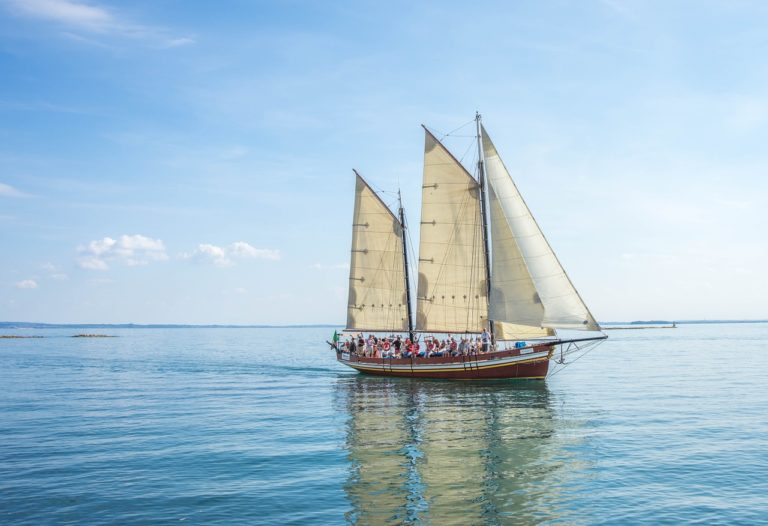
IX – Transport.
Choosing where you want to travel and for how long directly impacts the transport to be used.
Transport is one of the factors with the greatest influence on costs, and you can travel cheap or expensive, depending on your choices.
The most common means are:
- Buses: They are used more for short trips and between places that do not have air access.
- Trains: Along with buses, they are the most popular means, as they are cheap and one or the other is always available.
- Aerial: They are used for long distances or the need for speed. They are generally very expensive, but today there are many options that can sometimes be cheaper too.
- Boats: They are used where crossing the water is unavoidable or because it is cheaper. In some situations it may be the only way to get there, like some communities in the Amazon.
- Alternative or exclusive means: Today we have many forms of transport such as renting cars, motorbikes, trucks, bicycles, etc. These are means normally used for personal needs or ease/quickness of movement.
X – Security.
A factor that greatly influences the quality of your trip is the safety of where you are traveling.
Of course, safety is important at any time in life, but when you’re traveling you don’t know the place and it becomes much more critical to know.
For those who already have some experience, you know that it is very different to be in Geneva, Switzerland or in Baixada Fluminense, Rio de Janeiro.
Unfortunately, Brazilian cities are very unsafe
However, we cannot fail to rule out that everywhere there is a risk of problems occurring, especially as a tourist, because you are not prepared you are a very easy target.
In my training with FBI agents, I don’t forget the scene set up to explain how violence works.
Imagine a shark swimming in the middle of a school of fish.
It will attack fish that are distracted, weak or vulnerable.
He will not go after the alert or stronger ones, as he knows they will escape.
Moral of the story, don’t be distracted from the shoal. This has gotten me out of many difficult situations.
Alligator that doesn’t walk, turns into a bag.
If you miss the opportunity to get out of the situation, you will be the next victim.
See my travel guides, which have lots of information about the safety of the place.
There are also some blogs that talk specifically about this topic, such as.
XI – Documents.
As security is an important factor and having the necessary and protected documents is essential for a good trip.
Basically we have two situations.
A – National trip.
If you are traveling in your country, the documents are the same as those for your everyday life, except if you are traveling with children or elderly people.
1 – If you are with children:
It is essential that the child carries some identification and a means of finding their parents or guardians.
It seems crazy, but the number of children lost during the holidays is huge.
One small oversight and the worst can happen.
You need to have your partner’s permission, as you never know when you might need it.
It is extremely important to have your vaccination card and any medical history, if any.
2 – If you are traveling with elderly people:
Also have a way of identifying and contacting those responsible, because due to the lack of knowledge of the place, many elderly people get lost and with the difficulties inherent to their age it is very difficult for them to explain where they are and where they should go.
Having a medical history also makes any necessary care easier and faster.
B – International travel
Now the situation is more complicated.
It is imperative to have the necessary documentation, as without it everything can become a nightmare.
List of required documents:
1 – The first and most important thing is your passport.
In general, it must be valid for at least 6 months from the date you enter the country, never less than that.
Make sure that your ticket and accommodation details match your name on your passport.
2 – The second most important thing is whether you need a visa.
If you are Brazilian, check the Itamaraty consular portal to see if you need a visa, but even if it says you don’t need a visa, consult the consulate or embassy of the country you are visiting to be 100% sure.
If you are not Brazilian, consult your country’s embassy.
Be careful with countries that only make one connection, that is, your plane will land and you will take another flight. Many require special permission for this to occur.
NOTE: Never travel to a country that requires a visa in advance without obtaining it first. You will be denied entry.
3 – Vaccinations or medical declaration.
Check the required vaccinations and have the international certificate.
If you have a medical condition that requires continuous medication, it is prudent to take the prescription and the doctor’s statement (in English), with the active ingredient of the medicine, as each place has a different name and with the name of the active ingredient it is easy to find the right.
If you have a pacemaker, you must notify the agents at the airport before the x-ray inspection and take the official card with you, usually provided by the doctor or pacemaker manufacturer.
XII – Cost of the trip
Now that you know where you are going, when, with whom, what time of year, hotel, means of transport, etc. It’s time to put all this in the spreadsheet and close the account.
To use, just delete the example data and add your own.
XIII – Be careful with your money.
If your trip is national, it’s the same precautions you take on a daily basis, but if it’s international you have to take some measures
For international travel:
Each country has its currency, rules, costs, payment methods and some methods may not be available.
It is extremely important to have good planning, as being in a situation without being able to pay for what you need is very unpleasant.
Let’s check the main payment methods with their advantages, disadvantages and cost.
1 – Cash.
In most places, having cash is the easiest and cheapest way to buy things.
Every day, countries are more prepared for other means of payment, but nothing like cash.
The big problem is the possibility of being stolen or lost and the difficulty of obtaining coins from countries outside convertible currencies, such as Bath in Thailand.
2 – Credit card.
Today, it is widely accepted anywhere in the world. The main brands are accepted in the main stores, services, internet and cities around the world.
There are many places, especially in small towns, that do not accept credit cards, and some businesses add a fee for using the card.
The exchange rate changes until the card were paid.
For Brazilians, there is still an IOF increase of 6.38%
3 – Debit card.
They are accepted in the best cities in the world and, of course, depending on the type of current account you have, it is possible to pay by direct debit from your account.
The IOF is only 0.38%, but there are still few places that accept this type of payment.
4 – ATM (automated teller machine)
ATM is an ATM where you can withdraw money in another currency and in another country using your credit card or current account.
Great option to have local currency, without paying the costs of exchanging currencies.
You also don’t need to carry around cash in coins, just use it when you need it.
May not be available everywhere.
5 – Payment by applications.
Many banks and credit cards have apps that allow you to make payments with your mobile device.
There are also others that are not physically linked to cards or banks, but use them to process payments.
We have Paypal, Alipay. Wechat in China.
It is important to check with your bank the costs of each type of operation.
In addition to the availability of services, they may not be available everywhere.
XIV – Applications.
We have many apps that can help you on your trip.
A – Before the trip.
This step can be very simple or complicated depending on the number of places you want to visit.
If you are staying in just one city, simply do an internet search to check available transport.
If there are several cities, you need to use some tools to research whether there is a connection between them. A great option is to use the Rome2Rio website. Which shows the best ways to get from one place to another, also showing the cost of each means of transport.
Although Rome2rio will give you an overview of costs, airfare can vary a lot, so it’s best to check flights on Skyscaner.
Based on the itinerary, transportation time and your list of what you want to see in each place, write down the data collected in the spreadsheet.
Depending on the list of tourist attractions you want to visit, use sites like Tripadvisor to find out the duration and costs of each tour.
With this effort you will already have a skeleton of the itinerary, with information on time in each place, transport and costs.
B – During the trip.
1 – Use a map application.
As you will be in an unfamiliar location, using a map app can help you find everything you need.
There are many options out there like Google maps, I really like using map.me where you can download the map of the location and use it even when you don’t have internet access. I used it on my trip around the world and I never got lost anywhere in the world. See my trip here.
2 – Use a translation app.
If it’s an international trip, a translation app is also very useful, today one of the best is Google translator.
I used it and Itranslate on my trip around the world and I got along very well.
The current version (April/2019) of Google Translate is very good with the following features.
Offline mode: Bringing up to 59 languages available in offline mode
Translator camera: Just aim the camera and wait for content to be recognized with instant translations. Works for up to 38 languages
Camera mode: Take a photo of the text and perform an efficient translation whenever you want. It supports 37 languages
Talk mode: Performs instant two-way voice translation. Supports up to 32 languages
Handwriting mode: Replace the keyboard and draw characters with understanding for up to 93 languages.
XV – Food
For this moment, use the Numbeo website which shows the cost of living in relation to your city and where you want to go.
This will give you an approximate cost of how much you will spend, but remember.
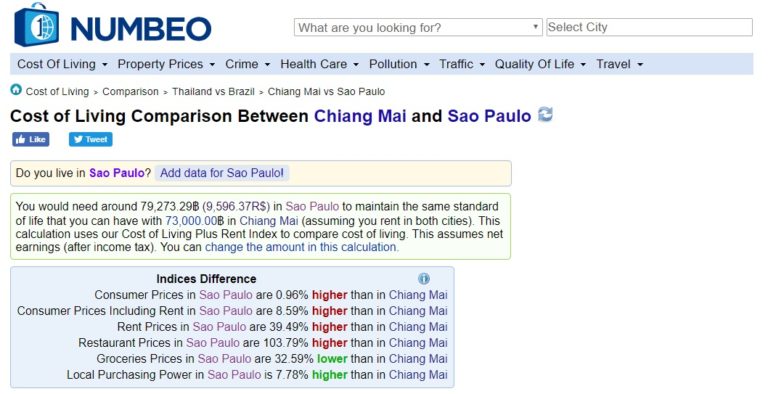
There are many ways to save on your food.
I will talk about this in another post.
XVI – Travel tips
You have two ways to find the best travel tips.
Sign up, as below, for the newsletter, where I will be sending you everything that is most relevant about travel.
Explore the site, starting with the Blog, where you will find everything you need for your trip, and then slowly go through the destinations where I have been and where I will be soon.
